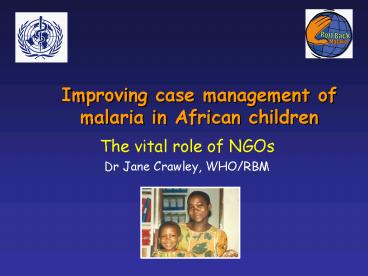Improving case management of malaria in African children PowerPoint PPT Presentation
1 / 37
Title: Improving case management of malaria in African children
1
Improving case management of malaria in African
children
- The vital role of NGOs
- Dr Jane Crawley, WHO/RBM
2
Mortality from malaria
- 90 in African children
- Most deaths occur in the community
3
Uninfected 1 Asymptomatic infection Uncompl
icated malaria 2 Severe
malaria 3 DEATH 1 Provision of
bednets 2 Recognition and prompt treatment 3
Recognition, prompt treatment and referral
4
Trends in malaria mortality
5
The big problems
- Drug resistance
- Weak health systems
- Poverty
6
Combined failure rates with WHO in vivo test
- Place Date CQ SP 1st line
- Kenya (Kisumu) 2000 gt75 40 SP
- Tanzania (Mkuzi) 1999 gt75 34 SP
- Rwanda (Rwaza) 2000 50 16 SP/AQ
- Uganda (Aduku) 1999 21 17 CQ/SP
- Zambia (Isoka) 1999 49 16 Changing
- DRC (Kinshasa) 2001 37 9 CQ
- Mali 1999 4 4 CQ
- (Doneguebougou)
7
Combination therapy
8
Efficacy of combination therapy
9
Favoured CT options
- SP Artesunate
- AQ Artesunate
- CoArtem (lumefantrine/artemether)
- SP AQ
10
(No Transcript)
11
Implications for NGOs
- Drug failure
- need for careful follow-up
- consider drug efficacy monitoring
- Finance
- advanced budgeting in anticipation of increased
drug costs - lobby government over application to Global Fund
- Compliance
- support co-packaging initiatives
12
Other drugs
13
Clinical implications of drug resistance
- Recrudescent parasitaemia
- Anaemia
- Increasing mortality
14
The burden of malarial anaemia
- Each year in children lt 5 years
- 1.4 - 5.7 million cases
- 190,000 - 974,000 deaths
- Case fatality rate of severe anaemia
- 13.4 - 17.2
- Highest mortality in infants
15
Clinical diagnosis of anaemia
- Need to detect
- Those needing treatment (Hb lt11g/dl)
- Those needing transfusion (Hb lt5g/dl)
- Methods
- Clinical signs
- WHO Haemoglobin Colour Scale
16
Diagnostic methods
Sensitivities Hb lt11 24 - 74 Hb lt11 75 -
85 Hb lt8 37 - 81 Hb lt 8 82 - 87 Both
will overestimate anaemia in areas of low
prevalence
17
Treatment
- Treatment
- Iron, antimalarials, antihelminthics
- Refer for transfusion if severe
- Is transfusion possible at district hospital?
- Implications for NGOs
- Support donation programmes
- Provision of paediatric blood bags
- Laboratory consumables
18
New prospects for prevention
- Intermittent presumptive treatment with SP
(Ifakara, Tanzania) - at 2, 3, and 9 months
- delivered via EPI
- 60 reduction in clinical malaria
- 50 reduction in severe anaemia
- BUT would it work in other settings?
- Need for large-scale implementation studies
19
Severe malaria
- Triage
- Resuscitation
- Antimalarials and antibiotics
- Supportive care
20
(No Transcript)
21
The importance of clinical triage
- Prostration
- Respiratory distress (deep breathing, chest
indrawing) - Easy and quick to perform
- Accurately identifies the children at highest
risk of dying
22
Resuscitation
- Check If Treatment
- Convulsions Lasts gt5 minutes Diazepam i/v
- Conscious level Not localising pain LP n/g
tube - Hydration Dehydrated i/v N-saline
- Circulation Shocked i/v N-saline or
blood - Blood glucose lt 2.2mmol/l i/v glucose
- Hb lt 5g/dl Transfuse
23
Antimalarials and antibiotics
- In hospital
- i/v quinine or i/m artemether
- i/v chloramphenicol/benzyl penicillin if LP not
possible - At health centre (pre-referral treatment)
- i/m quinine or i/m artemether
- i/m chloramphenicol
- Role of rectal artesunate?
24
Supportive care
- Fluids
- Regular observation
- conscious level
- respiratory rate
- blood glucose
- haemoglobin
25
Referral systems
Shop HOME CHW HC Hospital Traditional
healer Syndromic management relies upon
functioning referral systems
26
How can NGOs improve referral systems?
- The problem
- Failure of disease recognition
- Lack of transport
- Low expectations of health services
- The solution
- Community level training (mothers, CHWs, THs,
shopkeepers) - Transport provision
- Support local health facilities (clinics,
hospital)
27
Supporting health facilitiesNGOs can play a
vital role
- Ownership
- Staffing
- Support training and supervision
- Supply extra staff?
- Resources
- Dextrostix, 50 dextrose, blood bags?
- Transfusion service, laboratory support
- Importance of needs analysis
28
Diagnostics Contact martinezgarciab_at_who.int
29
Diagnosis based on clinical features
Disadvantages Lack of precision Over-treatment
Advantages Cheap Fast
30
Diagnosis based on microscopy
Advantages Gold standard Quantitative Useful for
other diseases
Disadvantages Time consuming Relies upon good
microscopes, reagents, and trained technicians
31
(No Transcript)
32
Rapid diagnostic tests
- Advantages
- Sensitive
- Fast
- Simple to perform
- No need for special equipment or electricity
- Disadvantages
- HRPII
- Not suitable for non Pf species
- Remains positive for 2 weeks after treatment
- Not quantitative
- Expensive (US0.60-2.50 per test)
33
RDTs in Africa?Current situation
- Problems
- Asymptomatic parasitaemia
- Expense
- Special situations
- Complex emergencies
- Malaria epidemics
- Low transmission settings
- Military
- Travellers
34
RDTs in AfricaFuture options
- Changing cost-benefit
- Rising drug costs
- Possible uses
- Confirmation of treatment failure (pLDH)
- Severe disease in peripheral settings
- BUT
- Will RDT diagnosis change clinical practice?
- Need for operational studies
35
Summary
- Technical information
- Drug resistance
- Combination therapy
- Anaemia
- Severe malaria
- Diagnostics
- The unique position of NGOs
- Provision of effective drugs
- Training
- Referral systems
- Operational research
36
The real challengefor NGOs and RBM
- SCALING UP district-level activities
- Need for NGO involvement in national plans
- What can RBM do to support you?
37
Thank you

